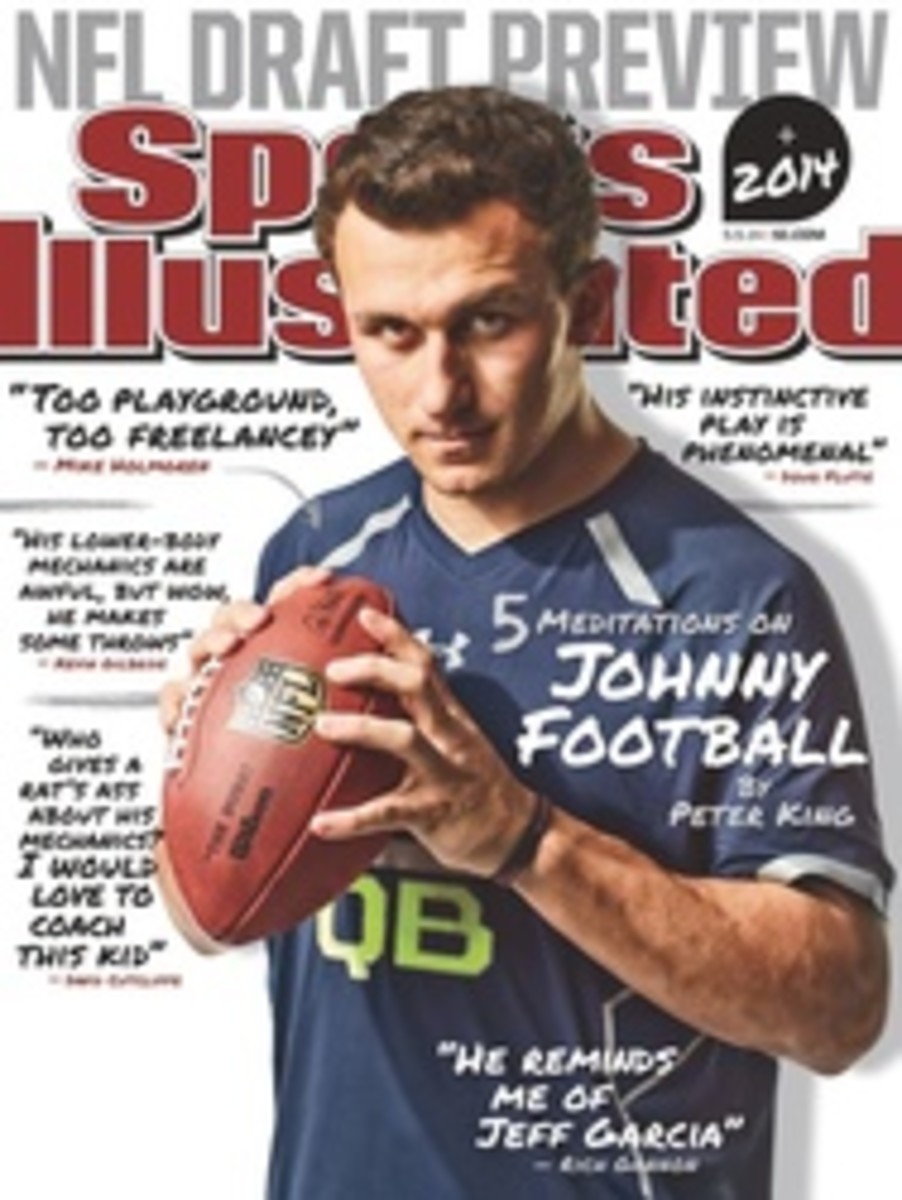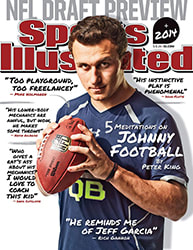
BACKSLIDE
BISHOP SANKEY has spent the past three months promoting not just himself but also his position. "I think running backs are still valuable," says the former University of Washington tailback. "They're a big part of the offense and a big reason why teams win as the season goes on."
While Johnny Manziel doesn't have to sell GMs on the value of his position, Sankey and his fellow top backs must convince NFL brass that they're worth a high draft choice even though they play a position that has been devalued in recent years. Leaguewide, carries by backs have dropped in seven of the past 10 seasons; the annual total was 557 fewer in 2013 than it was in '04. The change has been even more dramatic in the draft room. Between 1994 and 2003, the median draft position for a tailback was pick No. 105. From '04 to '13, it was No. 144.
To understand why teams are reluctant to risk a high pick on the position, look at the top of the 2012 draft. The Browns chose Alabama's Trent Richardson at No. 3, and he was trade bait a month into his second season. In two years with Cleveland and Indianapolis he has averaged just 3.3 yards a carry. Meanwhile, Tampa Bay's Doug Martin (No. 31 in the same draft) had an excellent rookie season but missed half of '13 with a shoulder injury. The Giants' David Wilson (No. 32) carried only 71 times as a rookie, then missed most of '13. Since backs are the only offensive players who, by design, routinely absorb collisions at full speed, injuries are to be expected. That understanding further helps explain backs' cumulative drop in the draft.
Rather than invest in the position early in the draft, teams can get more value by doing what the Packers did last year when they took Richardson's Alabama teammate Eddie Lacy in Round 2. In hindsight Lacy, who went on to finish No. 8 in the NFL with 1,178 rushing yards as a rookie, was an ideal tailback prospect. In his lone season as Alabama's primary ballcarrier, 2012, he proved himself capable in the rough-and-tumble SEC. But because he'd backed up Richardson and '11 first-rounder Mark Ingram before that, Lacy left school with only 355 career carries and plenty of tread left on his tires.
Lacy may be the model for future college backs: He didn't blanch when Bama coach Nick Saban suggested that a platoon system could make him a better NFL prospect, and he left college immediately after his first big season despite having another year of eligibility. "A lot of backs want to get the ball 20 or 30 times a game," Lacy told SI a few weeks before his final college outing, "but that wears your body down."
So how can a tailback improve his stock? For starters, he can show versatility. Sankey averaged 10.9 yards on 28 catches in 2013, and he wants NFL teams to know that he'll line up anywhere in the formation. Beyond that, the best course of action might be to accept a lower draft position (SI's mock draft has only Carlos Hyde going in the first two rounds, at No. 42), work to produce ... and then cash in on a fat second contract.
The highest-picked back in each of the past eight drafts shows a drop in confidence in (and compensation for) the position
No. 37
2013
Giovani Bernard
Bengals
4 YRS/$5.2M
No. 3
2012
Trent Richardson
Browns
4 YRS/$20.5M
*CBA kicks in, limits rookie deals
No. 28
2011
Mark Ingram
Saints
4 YRS/$7.4M
No. 9
2010
C.J. Spiller
Bills
6 YRS/$39.3M
No. 12
2009
Knowshon Moreno
Broncos
5 YRS/$16.7M
No. 4
2008
Darren McFadden
Raiders
6 YRS/$60M
No. 7
2007
Adrian Peterson
Vikings
5 YRS/$40.5M
No. 2
2006
Reggie Bush
Saints
6 YRS/$62M
PHOTO
AL BEHRMAN/AP
PHOTO
TOMASSO DEROSA/AP
PHOTO
DAVID BERGMAN FOR SI
PHOTO
DON HEUPEL/AP
PHOTO
ED ANDRIESKI/AP
PHOTO
DAVID BERGMAN FOR SI
PHOTO
JASON DECROW/AP
PHOTO
MICHAEL C. HEBERT FOR SI

